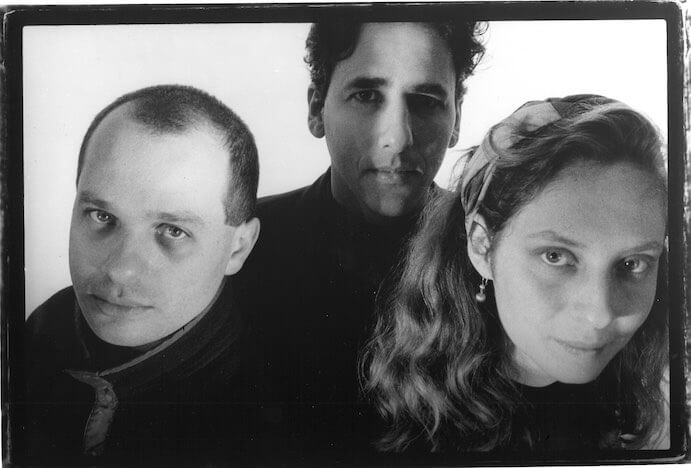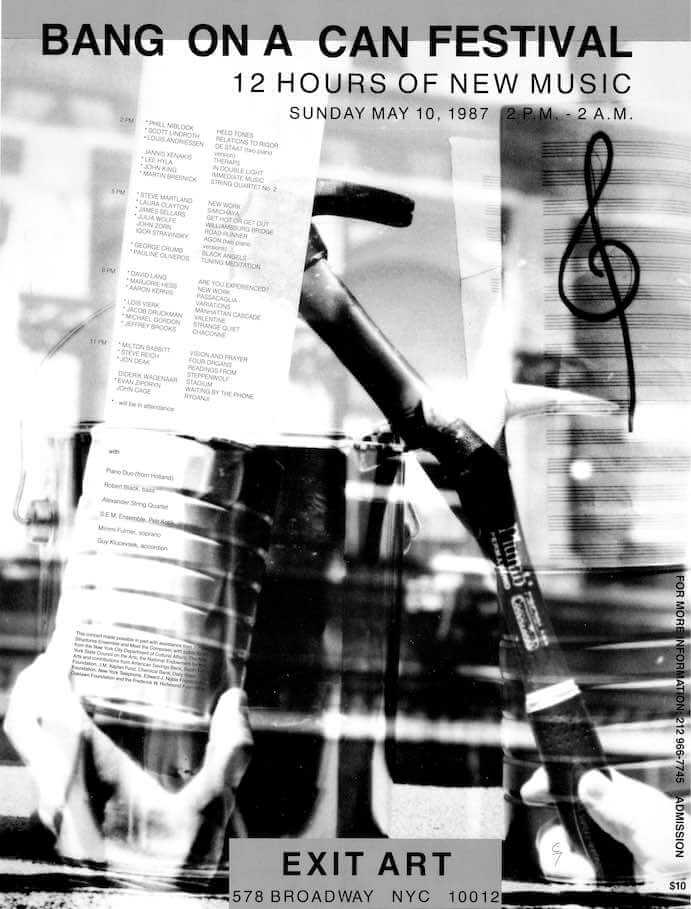Musicologist William Robin is an assistant professor of music at University of Maryland and an advocate for public musicology who regularly contributes to the New York Times and The New Yorker. During the coronavirus pandemic, Robin has continued to support his colleagues by organizing virtual musicology conferences amidst 2020’s many cancellations. He also has an excellent Twitter account (@SeatedOvation) and hosts the podcast Sound Expertise, which is back for its second season in March 2021.
His new book, Industry: Bang on a Can and New Music in the Marketplace is out on February 22, 2021 with Oxford University Press. In this book, Robin explores the creation, growth, and survival of the new music organization and ensemble Bang on a Can during the 1980s and 1990s. Coinciding with the release of Robin’s book, Bang on a Can will host their next virtual marathon on Sunday, February 21st, and you can catch Robin in conversation with Allan Kozinn on Monday, February 22nd at the virtual book release event hosted by 92nd Street Y.
You have been researching Bang on a Can for many years. What sparked your interest in this topic, and how did the project evolve?
In many ways it goes back to college, when I first fell in love with contemporary music–via reading Alex Ross’s The Rest Is Noise–and became really fascinated by the rich new music scene in New York in the early 2000s. I caught twelve hours of my first Bang on a Can marathon in 2010 at the World Financial Center and was hooked (I even live-blogged it, back when that was a thing!). In graduate school, I realized that there were significant musicological questions that could be asked of that scene, especially around how composers like Missy Mazzoli and Judd Greenstein imagined themselves as bridging musical genres and building entrepreneurial institutions for what was called (controversially), at that time, “indie classical.”
I wrote a dissertation that tried to scrutinize the history and ideologies surrounding indie classical, and the institutions that helped bring it into existence, including Bang on a Can. But as I moved towards writing a book, I realized that addressing Bang on a Can from a 21st century perspective wouldn’t be an adequate approach. In order to understand how that organization arose and what it meant to its creators, the composers David Lang, Michael Gordon, and Julia Wolfe, I had to go back to the 1980s when they founded it.
In researching my book, then, I focused on the 1980s and 1990s and tried to root myself in the perspective of an earlier generation of musicians: what did the priorities of three composers who were trying to carve out a space for themselves in 1987, by putting on an eclectic and irreverent marathon concert, look like? What was the institutional world that helped facilitate Bang on a Can’s growth in this period, from a scrappy downtown festival into an organization that played at Lincoln Center, signed a contract with Sony Classical, and commanded a sizable fanbase and budget?
As I spent more time interviewing musicians and administrators, and delving into various archives, I began to uncover a larger infrastructure, comprising funding agencies, orchestras, record labels, classical presenters, and ensembles, many of whom were preoccupied with the same central question that shaped Bang on a Can since its founding: how can contemporary music reach a broader audience? The book attempts to answer that question, by situating Bang on a Can within a broader institutional milieu and a dramatically shifting landscape for new music in the United States at the close of the twentieth century.

What was your reasoning and process behind writing this book for a broader audience rather than focusing on a strict academic study, and how do you approach the balance between the two?
To a certain extent, it was the natural result of how my work as an academic and my work as a quasi-journalist have intertwined over the last decade or so. In musicological journal articles and conference papers I’ve given, I tend to take a more deliberately “academic” tone, but as I found myself writing the book I realized, more and more, that I didn’t need as much jargon or heady prose in order to convey the arguments I wanted to convey and craft the stories I wanted to craft. I read a lot of narrative non-fiction while writing and that helped me find a way to balance my methodological and theoretical ideas with a style and structure that, ideally, will be accessible to musicologists and non-musicologists alike. I’d love it if composers and musicians check out the book: I hope it has some lessons for how to grapple with their roles as creative agents and institution-builders in the 21st century.
You describe Julia Wolfe, David Lang, and Michael Gordon’s career trajectories as the “standard model” for new music artists. Do you think this model is sustainable, and what might a more inclusive avenue for younger generations of musicians look like in order to thrive in new music without the support of what you call an “institutional infrastructure?”
To be honest, I’m not sure any career model for composers has been sustainable in the United States for more than a decade or two. The circumstances in which non-profit art can be created are constantly changing, sometimes for the better, and mostly for the worse.
One thing I try to lay out in the book is what it meant for a composer to try to have a “career” in the mid-1980s, and what that might have looked like for Wolfe, Lang, and Gordon compared to their predecessors. To generalize way-too-broadly, in postwar decades there were two general pathways for avant-garde composers–one could become a kind of Babbitt-style composer-theorist ensconced in the academy, or one could become a kind of Cage-style experimentalist hanging out in the Bay Area or lower Manhattan (we used to call these worlds “uptown” and “downtown”). Both of those pathways were facilitated, in varying ways, by Cold War-era patronage and ideologies (and cheap rent!). But the rise of minimalism and neo-Romanticism in the 1970s and ’80s offered the promise for composers to reach larger, non-specialist audiences, and build freelance careers.
The Bang on a Can founders picked up on those new possibilities in the marketplace and created their own organization from scratch, while also relying on a new set of institutional opportunities that emerged in the 1980s and ’90s. Subsequent generations of composers have followed in their image, crafting do-it-yourself careers by starting their own ensembles and festivals and record labels, both from a desire for creative freedom and as a response to the complete lack of a social safety net for artists in the United States. But much of the infrastructure that helped Bang on a Can–large granting organizations like Meet the Composer, a moderate amount of government funding, a record industry that paid artists–eroded in the 21st century, and the pandemic has only accelerated this.
Even as they continue to build their own entrepreneurial paths, I think U.S. composers need to think more and more about the idea of solidarity amongst themselves. And, perhaps, to start to imagine an organized movement of creative artists that could to ask, collectively, for more support from society–and, especially, more support from our government.

How do you respond to the current discussions in the fields of music theory and musicology about what Dr. Philip Ewell calls music’s “white racial frame?”
I am heartened to see that Dr. Ewell’s vital scholarship has been favorably received in many corners of academia. What some have called a “debate” or “controversy” around his scholarship has instead largely been a response to the unethical practices of another music theorist, and a journal issue that they edited in response to Ewell’s work which was deliberately slanderous, spiteful, and ultimately un-scholarly. There’s nothing to “debate” about Ewell’s broader argument, just as there’s nothing to “debate” about climate change. Music theory–and music studies more broadly–are rooted, institutionally and ideologically, in white supremacy, and Dr. Ewell is among several important scholars, including Matthew D. Morrison, Danielle Brown, and Tamara Levitz, who have recently drawn necessary attention to this issue.
What topics will your next research projects explore?
Minimalism! I’m currently working on a new book project with my friend Kerry O’Brien, a fantastic musicologist and percussionist in Seattle, titled Minimalist Music: A Reader. It will bring together a ton of primary sources–program notes, interviews, manifestos, reviews, etc.–in order to document the story of minimalist music from the 1950s to the present. We’re trying to tell a revisionist history by weaving together new perspectives on the big names like Philip Glass and Meredith Monk, incorporating more obscure figures like C.C. Hennix and Pandit Pran Nath, and of course addressing composers who have received renewed attention recently, like Julius Eastman and Maryanne Amacher.
I CARE IF YOU LISTEN is an editorially-independent program of the American Composers Forum, funded with generous donor and institutional support. Opinions expressed are solely those of the author and may not represent the views of ICIYL or ACF.
A gift to ACF helps support the work of ICIYL. For more on ACF, visit the “At ACF” section or composersforum.org.
























